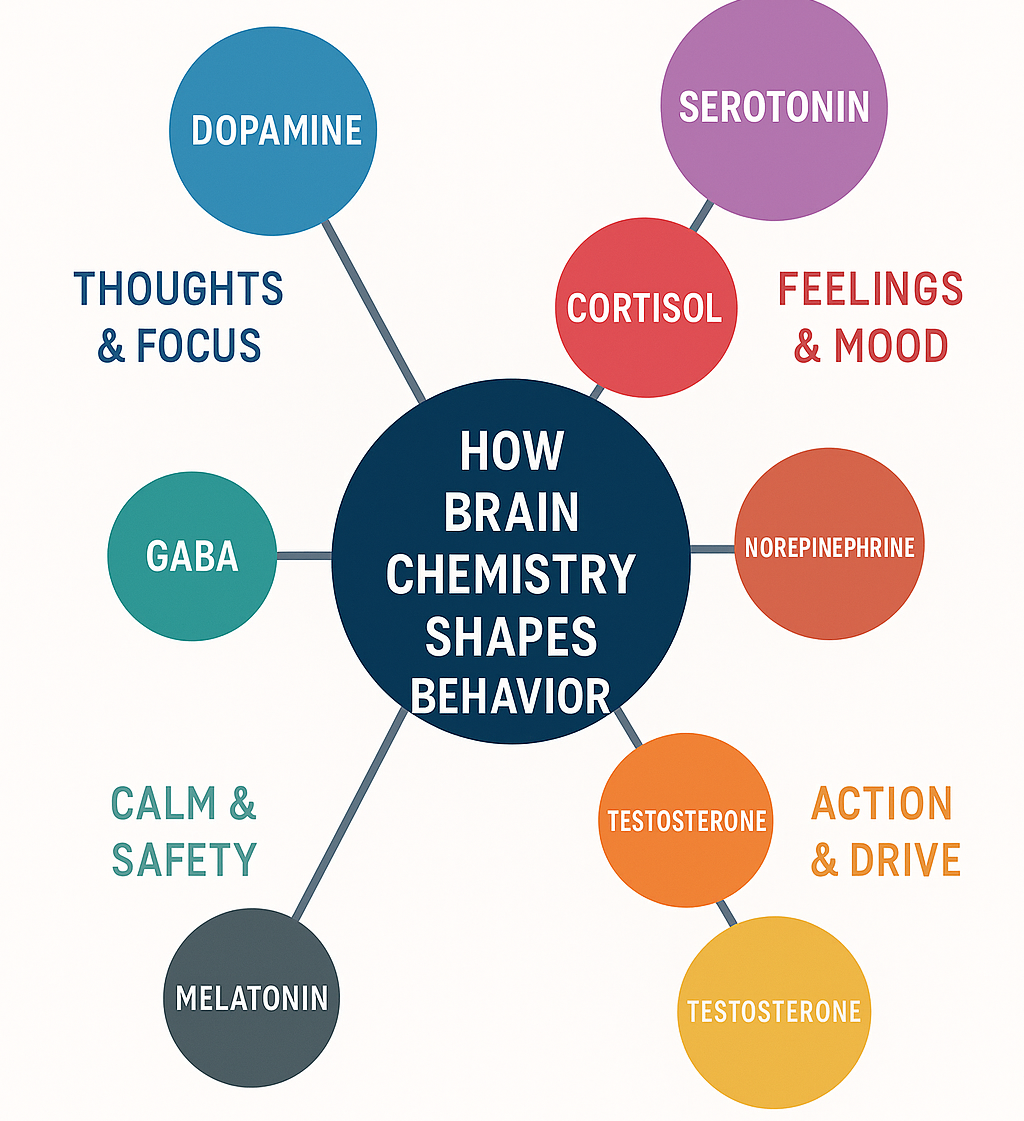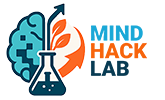How Brain Chemicals Affect Your Thoughts, Feelings, and Actions

🧠 How Brain Chemicals Affect Your Thoughts, Feelings, and Actions
Your brain and body are constantly being influenced by natural chemicals. These neurotransmitters and hormones are like messengers — they help you feel things, focus your thoughts, and decide how to act. Here's what the main ones do:
💭 Thoughts & Focus
- Dopamine: Your brain’s “goal getter.” It gives you the drive to chase rewards, learn new things, and build habits.
- Acetylcholine (not in the table but worth noting): Helps you stay focused and remember stuff.
💓 Feelings & Mood
- Serotonin: Helps you feel stable and calm. Low levels are linked to depression and anxiety.
- Cortisol: The stress chemical. It helps you handle tough situations, but too much over time can wear you down emotionally.
- Oxytocin: The “bonding” hormone. It kicks in when you feel close to someone or are caring for others.
🧘♀️ Calm & Safety
- GABA: Your brain’s “brake pedal.” It slows things down, helps you relax, and fights anxiety.
- Melatonin: Signals your body that it’s time to sleep. It rises at night to make you drowsy.
⚡ Action & Drive
- Norepinephrine: Gives you that alert, on-edge feeling when something important is happening — like during a test or emergency.
- Testosterone: Fuels confidence, assertiveness, and competition. Everyone has it (not just men), but levels vary.
🧩 What It All Means
Your feelings and actions aren’t random. They’re shaped by this mix of chemicals working together. For example:
- Feeling super focused and motivated? Likely high dopamine and norepinephrine.
- Calm and content? Your GABA and serotonin are doing their job.
- Stressed or anxious? Maybe your cortisol is too high or GABA too low.
- Struggling to sleep? Could be a melatonin issue.
✅ Bottom Line
Your brain chemistry plays a huge role in:
- How you feel
- What you pay attention to
- How you respond to life
Understanding these chemicals can help you build better habits, manage your emotions, and even improve your mental health.
| Chemical | Primary Role | Psychological Effect |
|---|---|---|
| Dopamine | Reward, motivation | Craving, habit, reinforcement learning |
| Serotonin | Mood regulation | Calm, satisfaction, reduced reactivity |
| Norepinephrine | Alertness, arousal | Vigilance, focus, fight-or-flight |
| GABA | Inhibition, calming | Relaxation, anti-anxiety |
| Glutamate | Excitation, memory | Learning, neural growth |
| Cortisol | Stress response | Anxiety, burnout, hypervigilance |
| Oxytocin | Social bonding | Empathy, trust, prosocial behavior |
| Testosterone | Assertiveness, drive | Confidence, risk-taking, competition |
| Estrogen | Emotional stability | Mood modulation, stress resilience |
| Melatonin | Sleep regulation | Drowsiness, circadian rhythm entrainment |
🔹 Dopamine
- Function: Reward, motivation, reinforcement learning, movement
- Where: Mesolimbic pathway (reward), nigrostriatal pathway (motor control)
- Evidence:
- Central to incentive salience (Berridge & Robinson, 1998)
- Altered in Parkinson’s disease (low dopamine) and addiction (highly dysregulated reward prediction)
- Key Effect: Drives goal pursuit, habit formation, reinforcement
🔹 Serotonin (5-HT)
- Function: Mood regulation, social behavior, impulse control, sleep
- Where: Produced in the raphe nuclei, acts widely in the brain
- Evidence:
- SSRIs improve depressive symptoms by enhancing synaptic serotonin (Cipriani et al., 2018, Lancet)
- Involved in emotion regulation and aggression inhibition (Carver et al., 2008)
- Key Effect: Regulates emotional balance and impulse inhibition
🔹 Norepinephrine (Noradrenaline)
- Function: Alertness, attention, arousal, fight-or-flight
- Where: Locus coeruleus origin, widespread cortical influence
- Evidence:
- Key in stress response and cognitive readiness (Arnsten, 2009)
- Altered norepinephrine linked to PTSD, ADHD
- Key Effect: Increases arousal, vigilance, and stress reactivity
🔹 GABA (Gamma-Aminobutyric Acid)
- Function: Brain’s primary inhibitory neurotransmitter
- Where: Found throughout cortex, basal ganglia, cerebellum
- Evidence:
- GABAergic drugs (e.g., benzodiazepines) reduce anxiety (Lydiard, 2003)
- Deficits linked to epilepsy, panic disorder, insomnia
- Key Effect: Calms overactive neural circuits, reduces anxiety
🔹 Glutamate
- Function: Brain’s main excitatory neurotransmitter; essential for learning and memory
- Where: Widespread in CNS, especially hippocampus
- Evidence:
- Synaptic plasticity via NMDA/AMPA receptors (Malenka & Bear, 2004)
- Excess = neurotoxicity in stroke, ALS, Alzheimer’s
- Key Effect: Increases signal strength, critical for learning
🔹 Acetylcholine
- Function: Learning, attention, memory, REM sleep
- Where: Basal forebrain and brainstem projections to cortex and hippocampus
- Evidence:
- Disruption linked to Alzheimer’s disease
- Nicotine enhances cholinergic transmission, improving attention short term
- Key Effect: Supports focused attention and encoding new information
🧬 HORMONES (Long-Term Systemic Regulators)
Hormones act more slowly but influence broader patterns like stress response, mood, sleep, bonding, and risk-taking.
🔹 Cortisol
- Function: Primary stress hormone, mobilizes glucose for energy
- Where: Secreted by adrenal glands under control of HPA axis
- Evidence:
- Chronic elevation linked to depression, insomnia, cognitive decline (McEwen, 1998)
- Diurnal cortisol rhythm dysregulated in PTSD and MDD
- Key Effect: Triggers energy release, increases alertness under threat
🔹 Adrenaline (Epinephrine)
- Function: Acute fight-or-flight hormone
- Where: Secreted by adrenal medulla
- Evidence:
- Rapidly increases heart rate and respiration during stress
- Acts alongside norepinephrine in acute stress states (Sapolsky, 2004)
- Key Effect: Prepares body for immediate action
🔹 Oxytocin
- Function: Bonding, empathy, trust, social affiliation
- Where: Synthesized in hypothalamus, released by posterior pituitary
- Evidence:
- Facilitates pair bonding and parental behavior in mammals (Feldman, 2012)
- Intranasal oxytocin enhances emotion recognition in some studies
- Key Effect: Enhances social connection and emotional trust
🔹 Testosterone
- Function: Aggression, competitiveness, dominance, libido
- Where: Gonads (testes, ovaries), regulated by hypothalamic-pituitary-gonadal axis
- Evidence:
- Related to dominance motivation, not just aggression (Carré & Olmstead, 2015)
- Sensitive to contextual factors like status threat
- Key Effect: Influences social dominance and risk preferences
🔹 Estrogen & Progesterone
- Function: Emotional regulation, cognitive flexibility, bonding
- Where: Ovaries; modulate serotonergic, dopaminergic systems
- Evidence:
- Estrogen modulates hippocampal plasticity (Woolley, 1998)
- Fluctuations tied to perimenopausal mood changes, PMDD
- Key Effect: Influence mood stability, emotional sensitivity
🔹 Melatonin
- Function: Regulates circadian rhythms and sleep
- Where: Pineal gland, secreted in darkness
- Evidence:
- Increases sleep onset and improves sleep quality
- Disturbed in insomnia, SAD, shift work disorder
- Key Effect: Promotes sleep and synchronizes biological clock
Sources & Further Reading
- McEwen BS (1998). “Stress, adaptation, and disease.” Annals of the NY Academy of Sciences.
- Berridge KC & Robinson TE (1998). “What is the role of dopamine in reward?” Brain Research Reviews.
- Arnsten AFT (2009). “Stress signaling pathways that impair prefrontal cortex structure and function.” Nature Reviews Neuroscience.
- Sapolsky RM (2004). Why Zebras Don’t Get Ulcers.
- Feldman R (2012). “Oxytocin and social affiliation.” Hormones and Behavior.
- Cipriani A et al. (2018). “Comparative efficacy and acceptability of 21 antidepressant drugs.” The Lancet.
- Carver CS, Johnson SL, Joormann J (2008). “Serotonergic function, two-mode models of self-regulation.” Psychological Bulletin.
